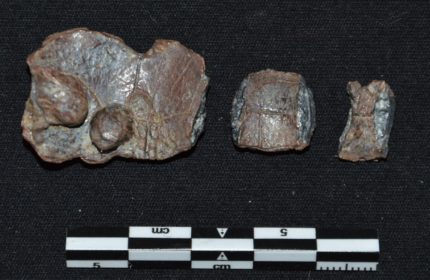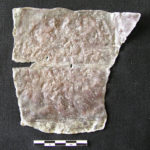 Thirty lead curse tablets have been discovered at the bottom of an ancient well in Athens. The well was discovered the Kerameikos, ancient Athens’ main cemetery built in potters’ neighborhood (keramos means potter’s clay) northwest of the ancient center next to the Dipylon gate in the city wall. The vast site used to be crossed by the Eridanos river before it was channeled in the classical period when the city walls went up. Its previous meandering path was prime real estate for wells, and with fresh water in short supply in Athens, public and private wells were dug in the Kerameikos. In 2011, the German Archaeological Institute, which has been excavating the site since 1913, launched a research project to document, map and excavate the Kerameikos wells and more than 40 have been counted so far.
Thirty lead curse tablets have been discovered at the bottom of an ancient well in Athens. The well was discovered the Kerameikos, ancient Athens’ main cemetery built in potters’ neighborhood (keramos means potter’s clay) northwest of the ancient center next to the Dipylon gate in the city wall. The vast site used to be crossed by the Eridanos river before it was channeled in the classical period when the city walls went up. Its previous meandering path was prime real estate for wells, and with fresh water in short supply in Athens, public and private wells were dug in the Kerameikos. In 2011, the German Archaeological Institute, which has been excavating the site since 1913, launched a research project to document, map and excavate the Kerameikos wells and more than 40 have been counted so far.
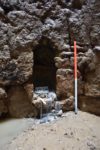 Well B 34 was discovered in the courtyard of the public bathhouse in front of the Dipylon. The round well shaft was built in the 4th century B.C. out of polygonal limestone blocks constructed in a corbelled technique — layers of rings that started out larger on the bottom and decreased in diameter as they rose to the top. The diameter at the bottom of the well is 9.5 feet. The diameter of the top is 3.6 feet. The well mouth was rimmed by a tufa stone, an unusual material for Greek well heads which were typically marble or white limestone.
Well B 34 was discovered in the courtyard of the public bathhouse in front of the Dipylon. The round well shaft was built in the 4th century B.C. out of polygonal limestone blocks constructed in a corbelled technique — layers of rings that started out larger on the bottom and decreased in diameter as they rose to the top. The diameter at the bottom of the well is 9.5 feet. The diameter of the top is 3.6 feet. The well mouth was rimmed by a tufa stone, an unusual material for Greek well heads which were typically marble or white limestone.
Groundwater filled almost 23 feet of the depth of the well, making the job of excavation challenging. The team had to deploy four water pumps to clear the well shaft sufficiently to excavate. They found a wealth of objects at the bottom: clay lamps, talus bones (ie, knucklebones) for dice games, bronze coins, cooking pots, drinking vessels (skyphoi), vessels for mixing water and wine (kraters) and kadoi, two-handled, wide-mouthed pots used to draw water from the well. Some organic remains were preserved in the water-logged environment, including peach pits, a potter’s scraper and a small wooden box.
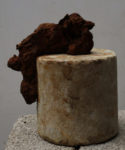 One notable survivor is a fragment of the wooden guide roller disk, part of the keloneion, the swing beam mechanism that lowered and raised vessels for water collection. A finely carved cylindrical piece of Pentelic marble with the remains of a heavily corroded iron chain attached to its upper side that was found in the well was also part of the mechanism. It was a counterweight, connected to one side of a horizontal beam mounted through the crotch of a trunk or vertical
One notable survivor is a fragment of the wooden guide roller disk, part of the keloneion, the swing beam mechanism that lowered and raised vessels for water collection. A finely carved cylindrical piece of Pentelic marble with the remains of a heavily corroded iron chain attached to its upper side that was found in the well was also part of the mechanism. It was a counterweight, connected to one side of a horizontal beam mounted through the crotch of a trunk or vertical 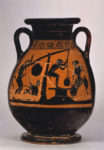 pole. The earliest known representation of this mechanism is on an Attic black-figure Pelike now in Berlin’s Antikenmuseum. Dating to around 490 B.C., it depicts two women and a Satyr at a well where a man, perhaps a slave, is operating the keloneion.
pole. The earliest known representation of this mechanism is on an Attic black-figure Pelike now in Berlin’s Antikenmuseum. Dating to around 490 B.C., it depicts two women and a Satyr at a well where a man, perhaps a slave, is operating the keloneion.
This well was in use for almost a thousand years, believe it or not, with occasional periods of abandonment in the wake of wars like Sulla’s siege and burning of Athens in 86 B.C. or of plagues. The Slavic invasions of the late 6th century A.D. put a permanent end to its use as a well, which was probably for the best given how much lead had been soaking in there for 800 years or so.
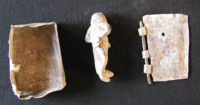 The lead curse tablets date to its earlier years in the 4th century B.C. and after. Burying curses with the dead was common practice in the classical period. Thirty-five lead curses have been found in tombs excavated at the Kerameikos, with a particular concentration of them in the graves of children and those killed in war. The spirits of people who died suddenly or before their time were considered to hover around the burial place, ideal messengers to convey curses to the infernal gods.
The lead curse tablets date to its earlier years in the 4th century B.C. and after. Burying curses with the dead was common practice in the classical period. Thirty-five lead curses have been found in tombs excavated at the Kerameikos, with a particular concentration of them in the graves of children and those killed in war. The spirits of people who died suddenly or before their time were considered to hover around the burial place, ideal messengers to convey curses to the infernal gods.
Wells and sacred pools were also seen as a non-stop conveyance to the chthonic deities. The well of a public bathhouse, almost certainly in active use during the night as evidenced by the clay lamps found at the bottom, would have been a very convenient spot for mailing a curse to the gods below.
Waters in rivers and wells, both protected by nymphs, was believed to provide direct access to the underworld, as [excavation director Dr. Jutta] Dr. Stroszeck says. The belief was that throwing the curse into a well would activate it.
The 30 new tablets have been documented using reflectance transformation imaging, an digital technique that enables even the smallest inscriptions on lead to be read. The archaeologists hope to ultimately learn the name of the nymph, the nature of the curses and whether the targets of the hexes were any of the famous Athenians living in the city during the late fourth century B.C.E.
